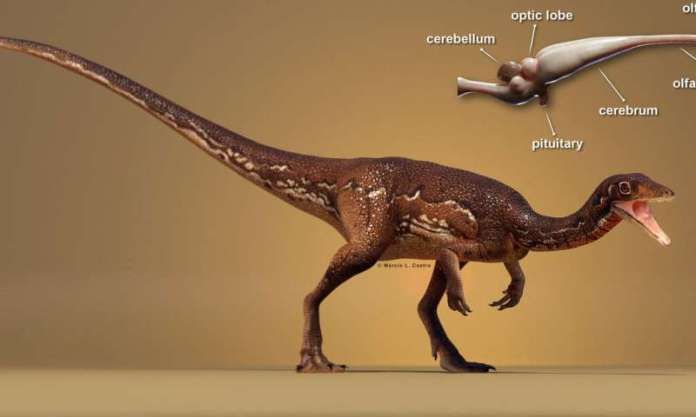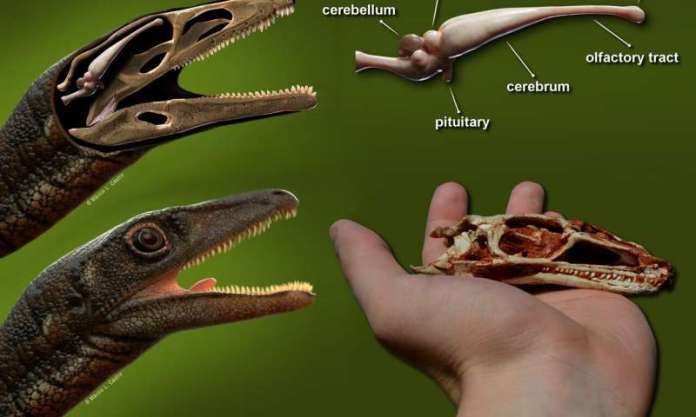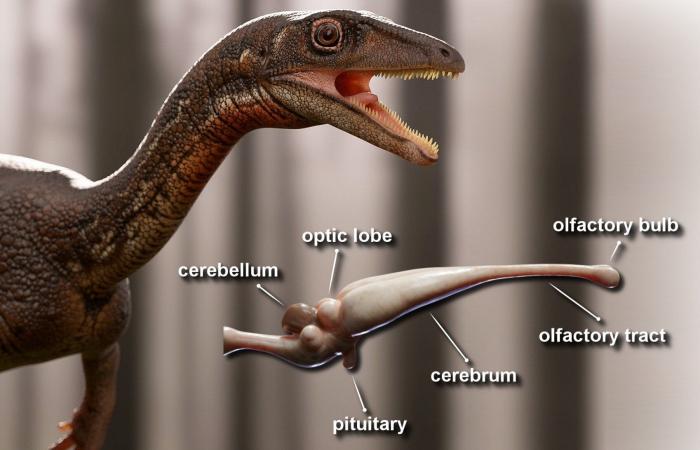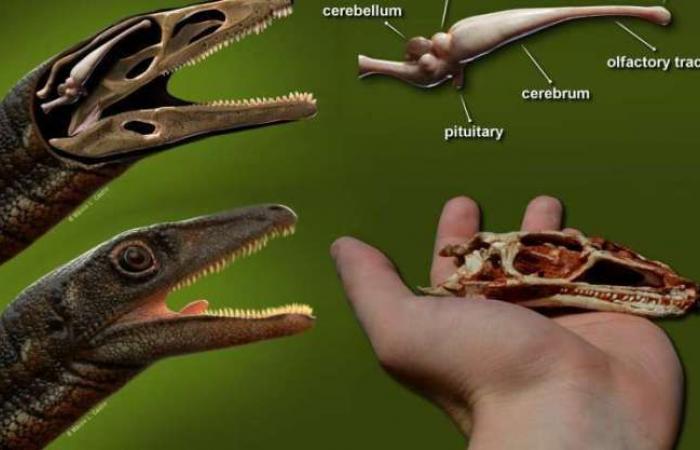Examining the brain of extinct organisms illuminates their behavior. However, soft tissues like the brain usually don’t last long. Therefore, researchers are reconstructing the brains of dinosaurs by analyzing the cranial cavities using computed tomography. It requires well-preserved brain envelopes that encase the brain tissue. So far, no complete and well-preserved neurocranias from the world’s oldest dinosaurs have been found.
A Brazilian paleontologist from the Universidade Federal de Santa Maria, Dr. Rodrigo Temp Müller, discovered an exceptionally well-preserved skeleton from a fossil site in southern Brazil in 2015. The roughly 233 million year old skeleton (Triassic) belongs to a small carnivorous dinosaur named Buriolestes schultzi, and the entire brain shell has been preserved. Now Brazilian researchers have reconstructed the first complete brain of one of the oldest dinosaurs in the world.
The study was published in Journal of Anatomy and performed by Rodrigo T. Müller, José D. Ferreira, Flávio A. Pretto and Leonardo Kerber from the Federal University of Santa Maria and Mario Bronzati from the University of São Paulo.
The Buriolestes schultzi brain is relatively small, weighing around 1.5 grams, which is slightly lighter than a pea. The shape was primitive and resembled the general morphology of a crocodile brain. In addition, the presence of well-developed structures in the cerebellum shows its ability to track moving prey. Conversely, the sense of smell was not high; Therefore, Buriolestes schultzi is more likely to hunt and track prey based on their visual abilities and sense of smell.
Despite the carnivorous feeding behavior of this dinosaur, it belongs to the lineage of giant, long-necked, herbivorous sauropods, the largest land animals to have ever lived. Buriolestes schultzi, however, is considered to be the earliest member of this line. The new brain reconstruction enables researchers to analyze the brain development of this impressive lineage.

One of the most noticeable trends is the increase in olfactory bulbs. While these structures responsible for the sense of smell are relatively small in Buriolestes schultzi, they become very large in later sauropods and closely related forms. Developing a strong sense of smell may be related to the acquisition of more complex social behavior based on the sense of smell of several groups of vertebrates. Alternatively, it has also been observed that high olfactory abilities played an important role in foraging for food and helped the animals to better differentiate between digestible and indigestible plants. Finally, another possible explanation for the increase in sauropods’ sense of smell is based on their ability to detect chemical clues to predators.

The scientists also calculated Buriolestes schultzi’s cognitive abilities, or intelligence, based on brain volume and body weight. The values obtained are higher than those of the giant sauropods such as Diplodocus and Brachiosaurus, suggesting a decrease in encephalization in the line. This is interesting because several other lines show an increase in encephalization over time. Even so, the cognitive ability of Buriolestes schultzi is inferior to that of theropod dinosaurs, the lineage that includes tyrannosaurus, velociraptor, and birds.
The rise of the dinosaurs was “more gradual,” as new fossil evidence suggests
More information:
Alex Schiller Aires et al. Development and development of the notary in Pterosauria, Journal of Anatomy (2020). DOI: 10.1111 / joa.13319
Provided by the Federal University of Santa Maria
Quote: Researchers reconstruct the first complete brain of one of the oldest dinosaurs (2020, November 3), retrieved from https://phys.org/news/2020-11-reconstruct-brain-oldest-dinosaurs.html on November 3, 2020 has been
This document is subject to copyright. Except for fair trade for the purpose of private study or research, no part may be reproduced without written permission. The content is provided for informational purposes only.
These were the details of the news The researchers are reconstructing the first complete brain of one of... for this day. We hope that we have succeeded by giving you the full details and information. To follow all our news, you can subscribe to the alerts system or to one of our different systems to provide you with all that is new.
It is also worth noting that the original news has been published and is available at de24.news and the editorial team at AlKhaleej Today has confirmed it and it has been modified, and it may have been completely transferred or quoted from it and you can read and follow this news from its main source.



